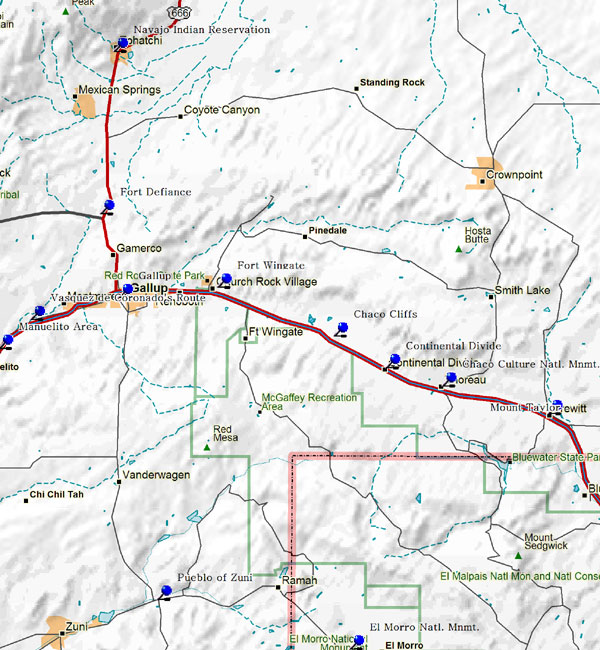
Great cliffs of red sandstone form the southern boundary of the San Juan basin. The strata exposed here are the gently upturned edge of the structural basin which contains coal, uranium, oil and gas resources. The Zuni Mountains to the south represent the old basement rock upon which the basin strata were deposited.
Chaco Canyon contains hundreds of sites documenting its Indian occupation from 5000 B.C. through the early 20th century. Most spectacular are a dozen large and excellently crafted masonry pueblos of the 11th and 12th centuries. After its abandonment around 1300, the canyon was settled by Navajos from the early 1700s until the 1940s.
Rainfall divides at this point. To the west it drains into the Pacific Ocean, to the east, into the Atlantic.
Until it was by-passed by the railroad in the 1880s, its watehole made El Morro an important stop for travelers in the Acoma-Zuni region. Numerous inscriptions carved in the sandstone date from the prehistoric, Spanish, Mexican, and Territorial periods in New Mexico's history. An important example is Onate's inscription, carved in 1605.
Now in the State of Arizona but then in the Territory of New Mexico, Fort Defiance was once described as "the most beautiful and interesting post as a whole in New Mexico." It was established in 1851 to control the Navajos, and abandoned as a military post in 1864.
The first Fort Wingate was established near San Rafael in 1862, to serve as the base of Col. Kit Carson's campaigns against the Navajos. In 1868 the garrison was transferred to the second Fort Wingate near Gallup. In that same year, the Navajos returned here after their imprisonment at Fort Sumner.
Long a major trading center for the Navajo and Zuni Indians living in communities north and south of the town, Gallup emerged in 1881 from a railroad construction camp. It is named for David Gallup, who in 1880 was paymaster for the Atlantic & Pacific (now the Santa Fe) Railroad.
This area contained many Indian pueblos dating from about A.D. 500 to 1325, when it was abandoned. Navajos settled here by 1800. This was the home of Manuelito, one of the last of the chiefs to surrender for confinement at the Bosque Redondo Reservation near Fort Sumner. The Navajos returned here in 1868.
One of the great volcanic cones of the Colorado Plateau, Mount Taylor rises to an elevation of 11,301 feet and last erupted some 2 million years ago. Numerous fissure eruptions since that time and as recently as about 1,200 years ago have created lava flows that form malpais or badlands along portions of the route.
Occupants of northwest New Mexico since the 16th century, the Navajos today comprise the most populous Indian group in the United States. The 17th, 18th and 19th centuries witnessed alternate periods of conflict and trading with their neighbors. The Navajos' economy traditionally has been based on stockraising, weaving, silversmithing, and more recently on mineral development.
The six original Zuni pueblos were the legendary "Seven Cities of Cibola" sought by Vasquez de Coronado in 1540. They were abandoned during the Peublo Revolt, and the present pueblo was settled in 1699 after the Spanish reconquest. In 1970, Zuni became the first Indian community to administer its own reservation affairs.
In July 1540, Francisco Vasquez de Coronado, leader of an army of Spaniards and Indians, entered New Mexico from Arizona to the south of here. He was seaching for the mythical Seven City of Cibola, which proved to be the six Zuni villages then located near the present pueblo. Vasquez de Coronado was nearly killed during his attack on Hawikuh.
|
